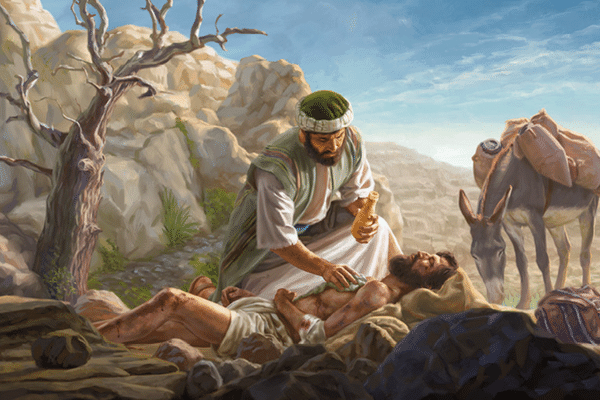National Good Samaritan Day

Today is National Good Samaritan Day. Bet you didn’t know that. Truthfully, I didn’t either until our Administrative Director told me. March 13 is designated as Good Samaritan Day.
The purpose of National Good Samaritan Day is just what you would expect—to encourage people to serve others as an act of compassion. Of course, the day gets its name from Jesus’ parable of the Good Samaritan (Luke 10). You may know the story well. A man on his way from Jerusalem to Jericho is attacked by robbers, beaten, and left for dead. A priest happens by but doesn’t want to get involved, so he passes by without helping the victim. A Levite (or lay minister) does the same. But when a Samaritan man comes that way, he feels compassion for the victim, stops, binds up his wounds, puts him on his animal of burden, and takes him to the nearest place where he can get additional treatment. When this [good] Samaritan has to continue his own journey, he pays for the victim’s continued care and promises to cover any additional expenses to help the man fully recover.
Why March 13?
Good Samaritan Day is always on March 13 because of something that happened 59 years ago on that day. A young, single woman named Kitty Genovese was attacked in the middle of the night in NYC, raped, and killed within steps of her apartment building. Sadly, that in itself was not so memorable an event. But when the New York Times reported the murder, they said there were 38 witnesses to the murder, 38 people who watched and/or heard Genovese’s screams for help without lifting a hand to help in any way!
This incident became so well known that it gave rise to a new psychological term: “the bystander effect.” Years later, when others dug into the story, they found that the original NY Times story was erroneous and, in fact, the Times admitted as much. There were not 38 witnesses to the murder who failed to come to Genovese’s aid. In fact, because it took place at about 3:00 in the morning, hardly anyone was aware of it at the time. However, by that time, the Genovese story had gained a life of its own and continues to be an inspiration for kindness and compassion even when that requires risky intervention.
National Good Samaritan Day is another example of taking a tragedy and attempting to bring something good from it. I, for one, am grateful for that effort. Like Random Acts of Kindness Day, about which I wrote last month, we need reminders to do what we already know we should do, regardless of how it came about.
To be or not to be a Good Samaritan
Even with the stimulus of National Good Samaritan Day, not everyone is convinced that helping people in need, particularly when there are risks, is a good thing. I once shared with a large group of men about the priority of serving people in need, after which one of them, a personal friend, said to me: “David, you know some of us have to be careful.” It was one of many times I wish I had thought quickly enough to say what my friend needed to hear—something like “Aren’t we glad the Good Samaritan didn’t think like that?”
By contrast, the fairly recent movie When the Crawdads Sing has a line we all need to hear. The movie is a story about a white girl about 8 or 9 years old being abandoned by her entire family, and she was left to survive on her own in the marshlands of NC. Eventually, she learned to harvest mussels from the marsh and trade them at a local grocery store for needed supplies. The store was run by a black couple who realized getting too involved in helping a white girl could lead to trouble for them. At one point, the husband said to his wife they should be careful to which she said with feeling: “The Bible don’t say nothing about being careful!”
That is the sentiment of the Good Samaritan.
What can you do?
I am grateful for National Good Samaritan Day but sad about the event that led to its establishment. The question is: What will we do to observe the day? What can you do?
Being a Good Samaritan doesn’t have to be something elaborate. In fact, in the spirit of Jesus’ parable, it can be simply responding to a situation or need that shows up, unplanned and unexpected. However, you will need two things to respond to an unexpected need—compassion and open eyes to see. Open your eyes today to the many needs that appear. They are all around . . . if we have eyes to see. Compassion will give you the motivation to step out of your routine to do what you can to respond to the need God puts in front of you.
Jesus tells us precious little about any of the characters in his story we call the Good Samaritan. I doubt the Samaritan in the story gave any thought to encountering a person in need when he set out for Jericho, but he did. Compassion is what differentiated his response from those of the priest and Levite, and it will for us, too. Genuine compassion that leads to action, helpful, caring action can make any of us a Good Samaritan . . . today and any day.
More about being a Good Samaritan
In my book Compassionaries: Unleash the Power of Serving, one entire chapter is devoted to the debate around whether or not we should risk danger to get involved in helping people in need. If you are interested in delving a little deeper into this issue than this blog can do, download a copy of the chapter here.
One more thing, please let me know what you did to observe Good Samaritan Day. I love to hear about others’ serving!



Leave a Reply